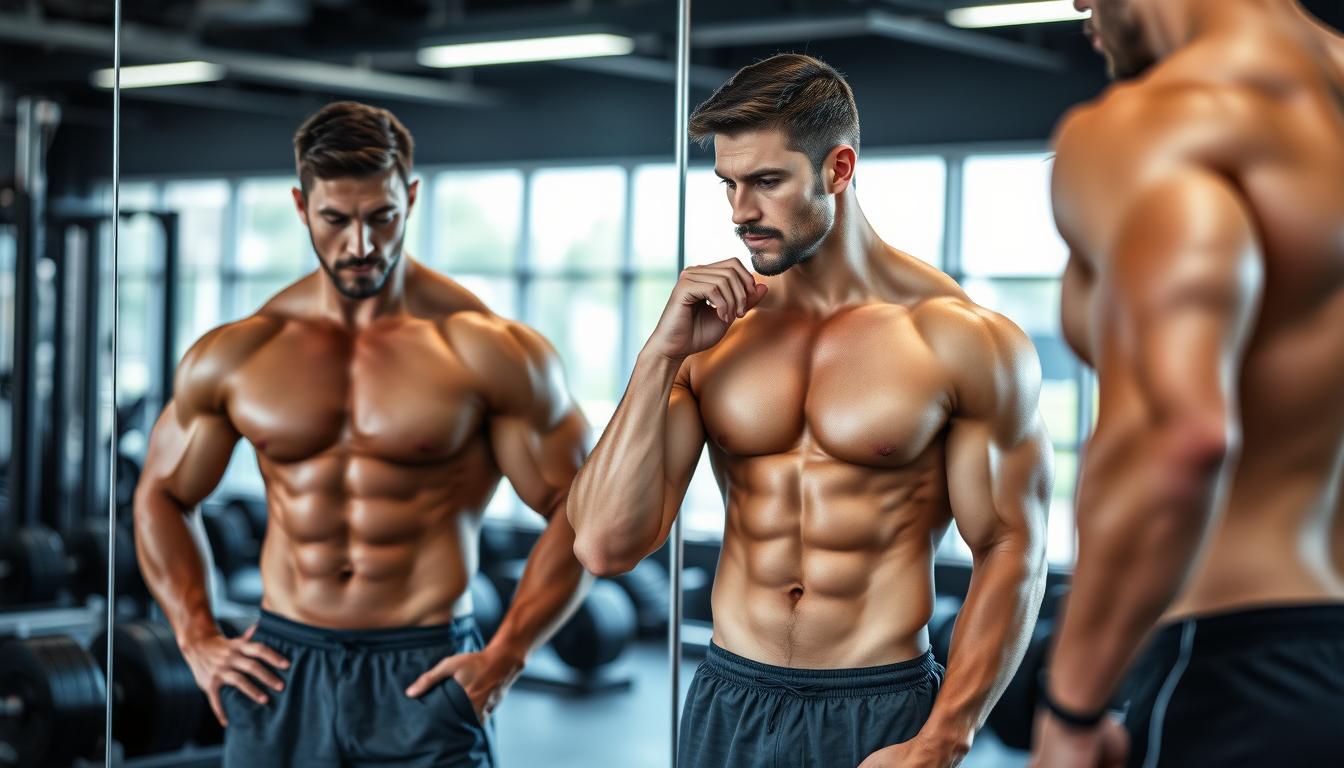Key Factors That Determine Ideal Weight for Tall Bodybuilders
For a 6’3 male bodybuilder, the concept of “ideal weight” is multifaceted and highly individualized. Several critical factors influence what constitutes an optimal weight for your specific situation:
Muscle Mass Development
Muscle tissue is denser than fat, meaning that bodybuilders typically weigh more than non-bodybuilders of the same height. A 6’3 male bodybuilder with significant muscle development may weigh considerably more than the “normal” weight range for that height while maintaining excellent health markers and low body fat percentage.
Body Fat Percentage
The percentage of your total weight that comes from fat significantly impacts your ideal weight range. Competition bodybuilders often maintain extremely low body fat percentages (3-7% for men during competition), while off-season bodybuilders typically maintain a more sustainable 8-15% body fat range.
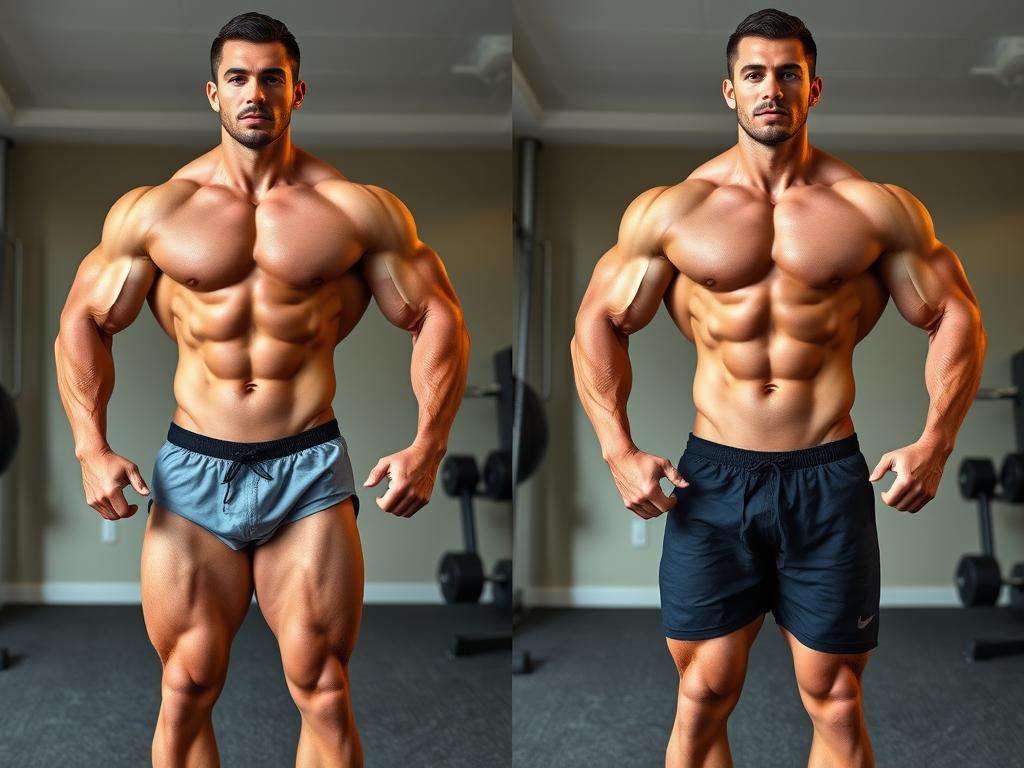
Competition Goals
Your competitive category and goals play a crucial role in determining your ideal weight. Different bodybuilding divisions have different aesthetic expectations:
- Classic Physique: Emphasizes proportions and aesthetics over sheer size
- Open Bodybuilding: Prioritizes maximum muscle mass while maintaining definition
- Men’s Physique: Focuses on a more attainable, athletic look with less extreme mass
Frame Size and Bone Structure
Even among 6’3 bodybuilders, natural variations in skeletal structure affect ideal weight. Wrist and ankle measurements can help determine if you have a small, medium, or large frame, which impacts how much muscle mass you can naturally support.
Not Sure About Your Ideal Frame Size?
Our frame size calculator considers your wrist circumference, ankle measurements, and shoulder width to determine your natural frame category.
Scientifically Backed Weight Range for 6’3 Male Bodybuilders
Based on scientific research and professional bodybuilding standards, here are the recommended weight ranges for a 6’3 male bodybuilder in different phases and categories:
| Bodybuilding Category | Competition Weight Range | Off-Season Weight Range | Body Fat % (Competition) | Body Fat % (Off-Season) |
| Men’s Physique | 200-215 lbs | 215-230 lbs | 5-8% | 10-15% |
| Classic Physique | 215-230 lbs | 230-245 lbs | 4-7% | 8-14% |
| Open Bodybuilding | 230-260+ lbs | 250-280+ lbs | 3-6% | 8-12% |
It’s important to note that these ranges represent general guidelines for competitive bodybuilders. Recreational bodybuilders may maintain higher body fat percentages year-round for better overall health and sustainability.
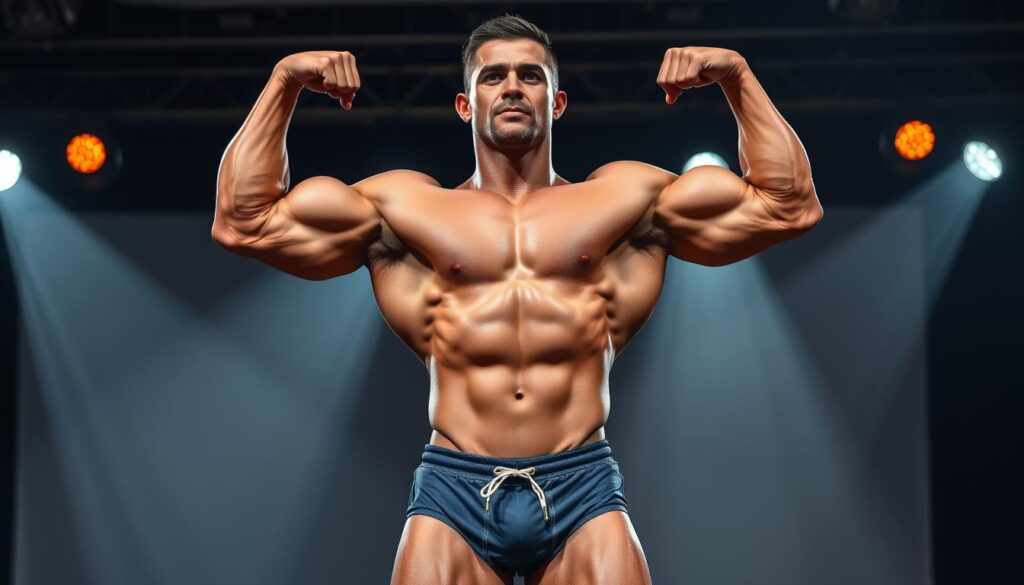
FFMI Considerations for Tall Bodybuilders
The Fat-Free Mass Index (FFMI) is a valuable metric for bodybuilders to assess their muscle development relative to their height. For a 6’3 male bodybuilder, here’s how to interpret your FFMI:
- 22-23 FFMI: Represents good muscle development for a natural bodybuilder
- 23-25 FFMI: Excellent muscle development, approaching natural genetic potential
- 25-27 FFMI: Elite level natural bodybuilder or potentially enhanced
- 27+ FFMI: Typically indicates enhanced bodybuilders

Calculate Your FFMI Score
Enter your current weight, height, and body fat percentage to determine your Fat-Free Mass Index and see how you compare to elite bodybuilders.
Bodybuilder Weight vs. Non-Bodybuilder Weight at 6’3″
The difference between a bodybuilder’s ideal weight and that of a non-bodybuilder at 6’3″ is substantial due to differences in body composition. Let’s examine how these weights compare:
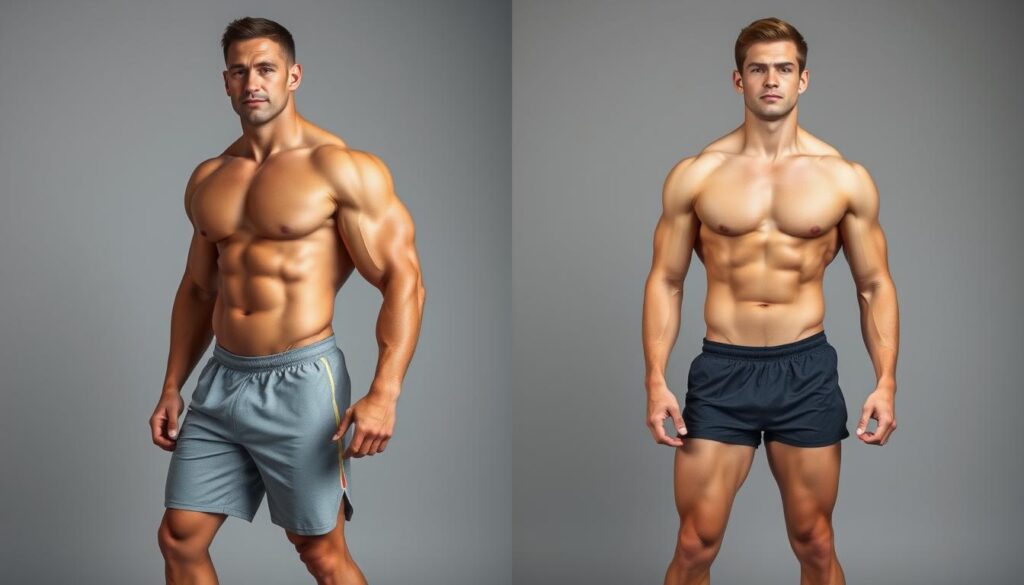
| Category | Weight Range | Body Fat % | Muscle Mass | Visual Appearance |
| Standard BMI “Normal” Range | 152-199 lbs | 15-20% | Average | Slim to average build |
| Athletic Non-Bodybuilder | 180-210 lbs | 10-15% | Above average | Fit, athletic appearance |
| Recreational Bodybuilder | 210-240 lbs | 8-15% | Significantly above average | Muscular, defined physique |
| Competitive Bodybuilder | 230-260+ lbs | 3-8% | Exceptional | Highly muscular, defined |
As the table illustrates, a 6’3 male bodybuilder’s ideal weight significantly exceeds standard BMI recommendations. While the BMI chart suggests 152-199 lbs as a “normal” range for this height, competitive bodybuilders often weigh 230-260+ lbs while maintaining excellent health markers due to their unique body composition.
“Standard height-weight charts are virtually useless for bodybuilders. At 6’3″, I compete at 245 lbs with 5% body fat, which would classify me as ‘obese’ on a BMI chart despite having excellent health markers across the board.”
Body Fat Percentage Targets for 6’3 Male Bodybuilders
Body fat percentage is a critical factor in determining the ideal weight for a 6’3 male bodybuilder. Different phases of training require different body fat levels to optimize results:
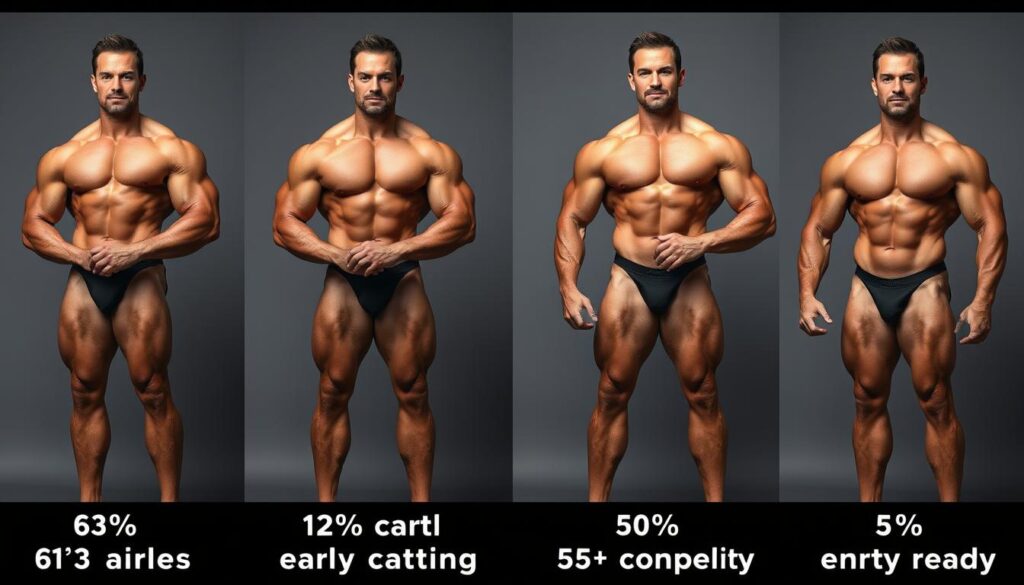
Bulking Phase (Off-Season)
During the bulking phase, 6’3 male bodybuilders typically maintain a body fat percentage between 10-15%. This slightly higher body fat level creates an optimal hormonal environment for muscle growth and strength gains. At this stage, a 6’3 bodybuilder might weigh 230-280 lbs depending on their muscle development and competition category.
Cutting Phase (Pre-Competition)
As competition approaches, bodybuilders enter a cutting phase to reduce body fat while preserving muscle mass. For a 6’3 male bodybuilder, the progression typically follows this pattern:
Early Cutting (12-14 weeks out)
- Body Fat: 10-12%
- Weight: 5-10 lbs below bulking weight
- Visible abs with good lighting
- Some vascularity in arms
Mid Cutting (8-10 weeks out)
- Body Fat: 7-9%
- Weight: 10-15 lbs below bulking weight
- Clearly visible abs in normal lighting
- Increased vascularity across upper body
Competition Ready (1-2 weeks out)
- Body Fat: 3-6%
- Weight: 15-25 lbs below bulking weight
- Maximum muscle definition and separation
- Pronounced vascularity throughout body
Important Note: Maintaining extremely low body fat percentages (below 6%) for extended periods is not recommended for health reasons. Competition-level body fat percentages should only be sustained for short durations around competitions.
Get Your Personalized Bulking & Cutting Plan
Our bodybuilding coaches can create a customized weight and nutrition plan based on your current stats, goals, and competition schedule.
Practical Tips for Maintaining Muscle Mass While Optimizing Health
For 6’3 male bodybuilders, maintaining an optimal weight that balances muscle mass, definition, and overall health requires strategic planning. Here are evidence-based strategies to help you achieve and maintain your ideal bodybuilding weight:

Nutrition Strategies for Tall Bodybuilders
Caloric Requirements
Taller bodybuilders typically require more calories to maintain muscle mass. For a 6’3 male bodybuilder, daily caloric needs often range from:
- Bulking phase: 3,500-4,500+ calories
- Maintenance: 3,000-3,800 calories
- Cutting phase: 2,500-3,200 calories
Protein Intake
Optimal protein intake for a 6’3 male bodybuilder:
- Bulking: 1.8-2.2g per pound of lean body mass
- Cutting: 1.2-1.5g per pound of total body weight
- For a 240 lb bodybuilder: 290-360g protein daily
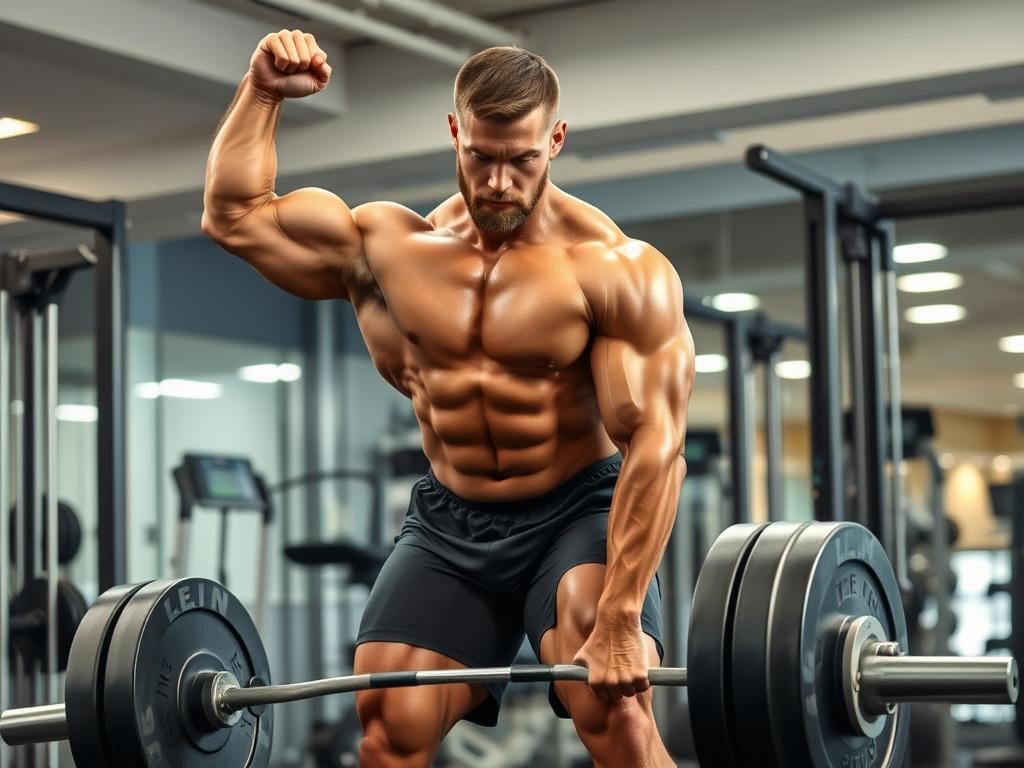
Training Considerations for Tall Bodybuilders
At 6’3″, bodybuilders face unique training challenges and advantages:
Leverage and Range of Motion
- Longer limbs create greater range of motion in exercises
- May require form modifications for optimal muscle activation
- Focus on full range of motion while maintaining proper form
Exercise Selection
- Prioritize exercises that accommodate longer limbs
- Consider using machines with adjustable components
- Incorporate specialized movements for lagging body parts
Recovery and Health Monitoring
Maintaining higher muscle mass requires diligent attention to recovery and health markers:
- Sleep: Prioritize 7-9 hours of quality sleep for optimal recovery and hormone production
- Health Screenings: Regular blood work to monitor hormones, lipids, and organ function
- Cardiovascular Health: Include regular low-intensity steady-state cardio to support heart health
- Joint Care: Implement preventative measures for joint health, especially important for taller bodybuilders

Optimize Your Training as a Tall Bodybuilder
Get our specialized training program designed specifically for bodybuilders 6’2″ and taller, with exercise modifications and techniques to maximize your genetic potential.
Finding Your Personal Ideal Weight as a 6’3 Male Bodybuilder
The ideal weight for a 6’3 male bodybuilder varies significantly based on individual factors including genetic potential, muscle-building history, competition goals, and overall health considerations. While the ranges provided in this article offer evidence-based guidelines, your personal ideal weight may fall outside these parameters based on your unique circumstances.
Rather than fixating solely on scale weight, focus on body composition metrics like body fat percentage, muscle symmetry, and overall proportions. For competitive bodybuilders, category requirements and aesthetic goals will ultimately determine your optimal competition weight.
Remember that sustainable progress and long-term health should always take precedence over extreme approaches to reach arbitrary weight goals. Work with qualified coaches and healthcare providers to develop a personalized approach that supports both your bodybuilding aspirations and overall wellbeing.

Speak With a Bodybuilding Coach Today
Get personalized guidance on determining your ideal competition weight, creating a nutrition plan, and optimizing your training as a 6’3″ bodybuilder.

